engine PONTIAC SOLSTICE 2008 User Guide
[x] Cancel search | Manufacturer: PONTIAC, Model Year: 2008, Model line: SOLSTICE, Model: PONTIAC SOLSTICE 2008Pages: 348, PDF Size: 5.23 MB
Page 81 of 348

THIRD (3), FOURTH (4) and FIFTH (5):Shift into
THIRD (3), FOURTH (4) and FIFTH (5) the same way
you do for SECOND (2).
To stop, let up on the accelerator pedal and press
the brake pedal. Just before the vehicle stops, press
the clutch pedal and the brake pedal, and shift to
NEUTRAL.
NEUTRAL:Use this position when you start or idle
your engine.
REVERSE (R):To back up, press the clutch pedal.
After the vehicle stops, shift into REVERSE (R). Slowly
let up on the clutch pedal as you press the accelerator
pedal. If it is hard to shift, let the shift lever return
to NEUTRAL and release the clutch pedal. Then press
the clutch pedal again and shift into REVERSE (R).
Do not attempt to shift into the �fth gear position prior
to shifting into REVERSE (R). Your transmission
has a lock out feature which prevents a �fth gear to
reverse gear shift.
Notice:Shifting to REVERSE (R) while your vehicle
is moving forward could damage the transmission.
The repairs would not be covered by your warranty.
Shift to REVERSE (R) only after your vehicle is
stopped.
Also, use FIRST (1) or REVERSE (R), along with the
parking brake, for parking your vehicle.Parking Brake
The parking brake lever is located between the
front seats.
To set the parking brake, hold the brake pedal down
and pull up on the parking brake lever. If the ignition
is on, the brake system warning light will come on.
SeeBrake System Warning Light on page 3-27.
2-25
Page 82 of 348
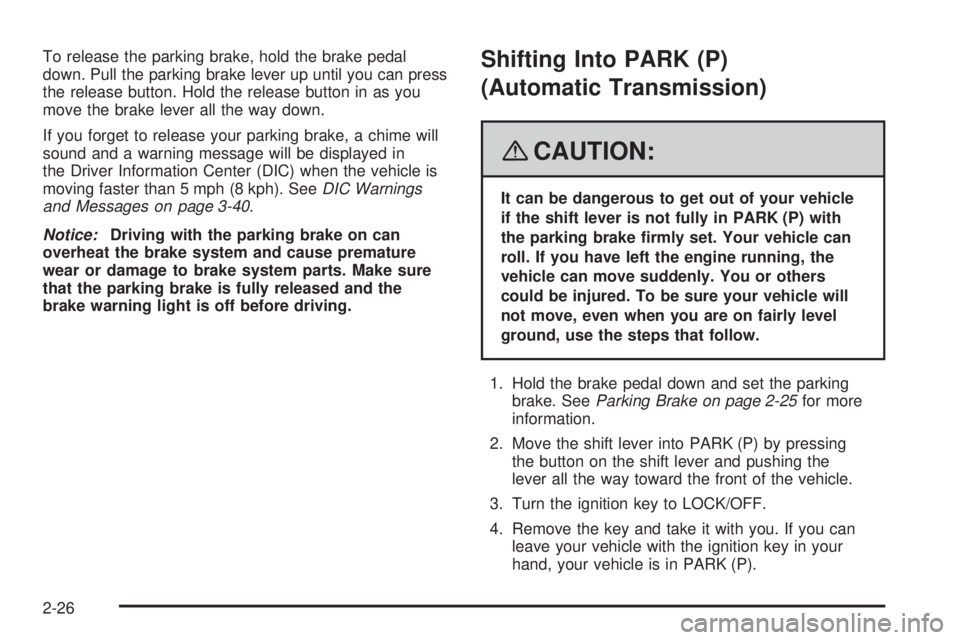
To release the parking brake, hold the brake pedal
down. Pull the parking brake lever up until you can press
the release button. Hold the release button in as you
move the brake lever all the way down.
If you forget to release your parking brake, a chime will
sound and a warning message will be displayed in
the Driver Information Center (DIC) when the vehicle is
moving faster than 5 mph (8 kph). SeeDIC Warnings
and Messages on page 3-40.
Notice:Driving with the parking brake on can
overheat the brake system and cause premature
wear or damage to brake system parts. Make sure
that the parking brake is fully released and the
brake warning light is off before driving.Shifting Into PARK (P)
(Automatic Transmission)
{CAUTION:
It can be dangerous to get out of your vehicle
if the shift lever is not fully in PARK (P) with
the parking brake �rmly set. Your vehicle can
roll. If you have left the engine running, the
vehicle can move suddenly. You or others
could be injured. To be sure your vehicle will
not move, even when you are on fairly level
ground, use the steps that follow.
1. Hold the brake pedal down and set the parking
brake. SeeParking Brake on page 2-25for more
information.
2. Move the shift lever into PARK (P) by pressing
the button on the shift lever and pushing the
lever all the way toward the front of the vehicle.
3. Turn the ignition key to LOCK/OFF.
4. Remove the key and take it with you. If you can
leave your vehicle with the ignition key in your
hand, your vehicle is in PARK (P).
2-26
Page 83 of 348
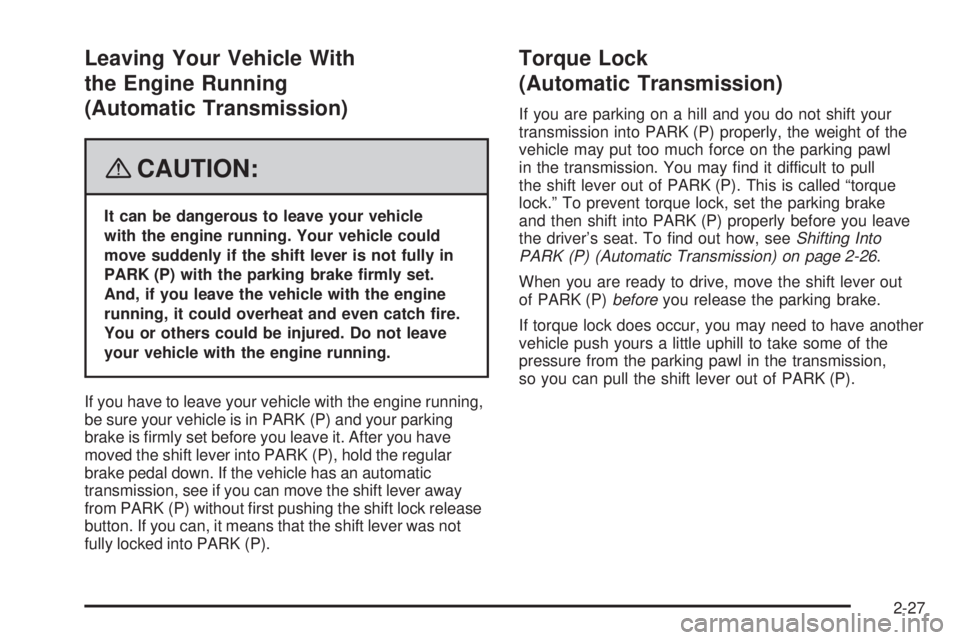
Leaving Your Vehicle With
the Engine Running
(Automatic Transmission)
{CAUTION:
It can be dangerous to leave your vehicle
with the engine running. Your vehicle could
move suddenly if the shift lever is not fully in
PARK (P) with the parking brake �rmly set.
And, if you leave the vehicle with the engine
running, it could overheat and even catch �re.
You or others could be injured. Do not leave
your vehicle with the engine running.
If you have to leave your vehicle with the engine running,
be sure your vehicle is in PARK (P) and your parking
brake is �rmly set before you leave it. After you have
moved the shift lever into PARK (P), hold the regular
brake pedal down. If the vehicle has an automatic
transmission, see if you can move the shift lever away
from PARK (P) without �rst pushing the shift lock release
button. If you can, it means that the shift lever was not
fully locked into PARK (P).
Torque Lock
(Automatic Transmission)
If you are parking on a hill and you do not shift your
transmission into PARK (P) properly, the weight of the
vehicle may put too much force on the parking pawl
in the transmission. You may �nd it difficult to pull
the shift lever out of PARK (P). This is called “torque
lock.” To prevent torque lock, set the parking brake
and then shift into PARK (P) properly before you leave
the driver’s seat. To �nd out how, seeShifting Into
PARK (P) (Automatic Transmission) on page 2-26.
When you are ready to drive, move the shift lever out
of PARK (P)beforeyou release the parking brake.
If torque lock does occur, you may need to have another
vehicle push yours a little uphill to take some of the
pressure from the parking pawl in the transmission,
so you can pull the shift lever out of PARK (P).
2-27
Page 85 of 348
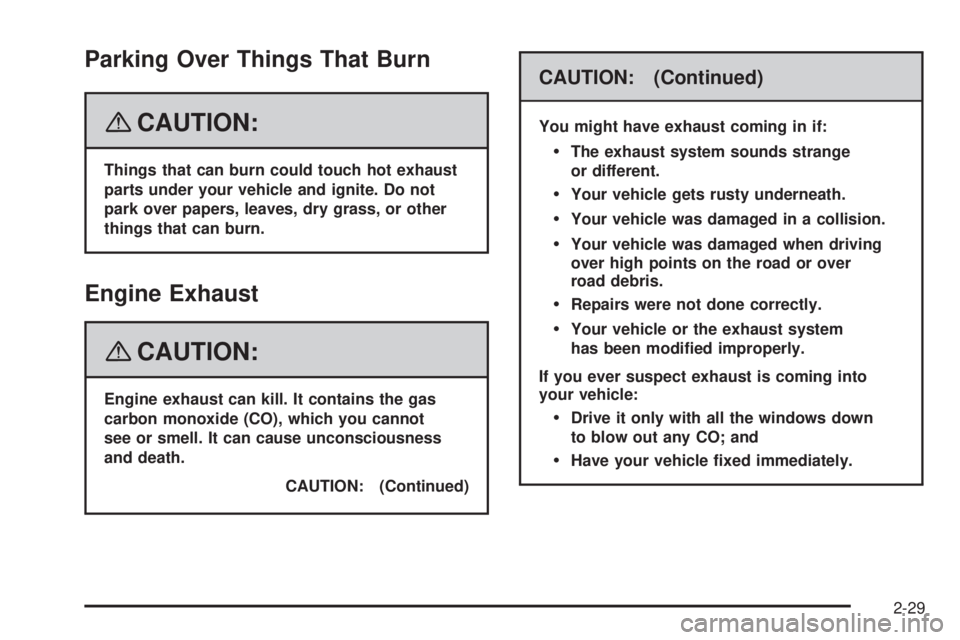
Parking Over Things That Burn
{CAUTION:
Things that can burn could touch hot exhaust
parts under your vehicle and ignite. Do not
park over papers, leaves, dry grass, or other
things that can burn.
Engine Exhaust
{CAUTION:
Engine exhaust can kill. It contains the gas
carbon monoxide (CO), which you cannot
see or smell. It can cause unconsciousness
and death.
CAUTION: (Continued)
CAUTION: (Continued)
You might have exhaust coming in if:
The exhaust system sounds strange
or different.
Your vehicle gets rusty underneath.
Your vehicle was damaged in a collision.
Your vehicle was damaged when driving
over high points on the road or over
road debris.
Repairs were not done correctly.
Your vehicle or the exhaust system
has been modi�ed improperly.
If you ever suspect exhaust is coming into
your vehicle:
Drive it only with all the windows down
to blow out any CO; and
Have your vehicle �xed immediately.
2-29
Page 86 of 348

Running the Engine While Parked
It is better not to park with the engine running.
But if you ever have to, here are some things to know.
{CAUTION:
Idling the engine with the climate control
system off could allow dangerous exhaust
into your vehicle. See the earlier caution under
Engine Exhaust on page 2-29.
Also, idling in a closed-in place can let deadly
carbon monoxide (CO) into your vehicle even
if the climate control fan is at the highest
setting. One place this can happen is a garage.
Exhaust — with CO — can come in easily.
NEVER park in a garage with the engine
running.
Another closed-in place can be a blizzard.
SeeWinter Driving on page 4-19.
{CAUTION:
It can be dangerous to get out of your vehicle
if the automatic transmission shift lever is not
fully in PARK (P) with the parking brake �rmly
set. Your vehicle can roll. Do not leave your
vehicle when the engine is running unless you
have to. If you have left the engine running,
the vehicle can move suddenly. You or others
could be injured. To be sure your vehicle
will not move, even when it is on fairly level
ground, always set the parking brake and
move the automatic transmission shift lever
to PARK (P), or the manual transmission shift
lever to NEUTRAL.
Follow the proper steps to be sure your vehicle will
not move. SeeShifting Into PARK (P) (Automatic
Transmission) on page 2-26andParking Your Vehicle
(Manual Transmission) on page 2-28.
2-30
Page 97 of 348
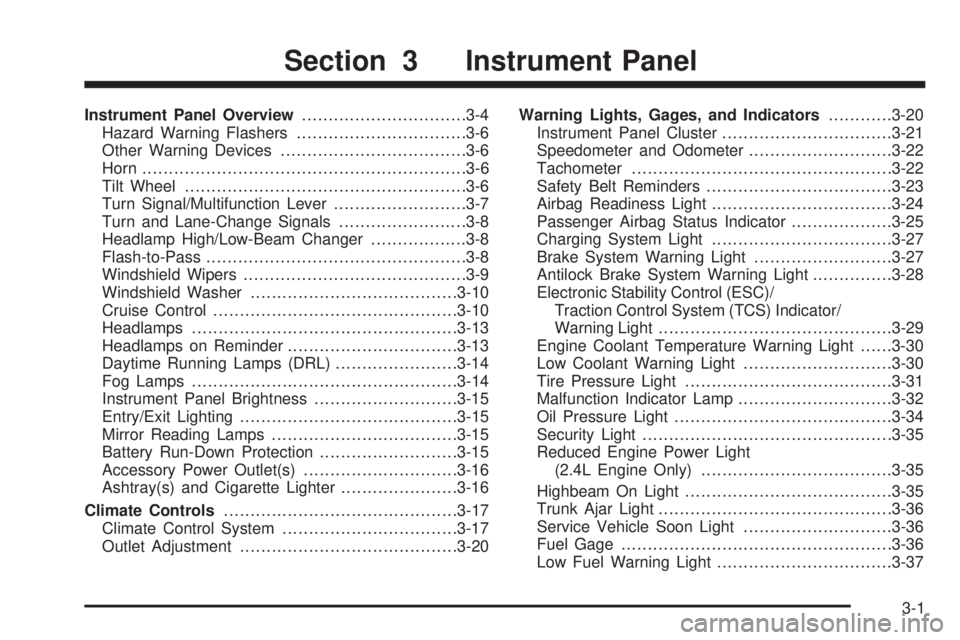
Instrument Panel Overview...............................3-4
Hazard Warning Flashers................................3-6
Other Warning Devices...................................3-6
Horn.............................................................3-6
Tilt Wheel.....................................................3-6
Turn Signal/Multifunction Lever.........................3-7
Turn and Lane-Change Signals........................3-8
Headlamp High/Low-Beam Changer..................3-8
Flash-to-Pass.................................................3-8
Windshield Wipers..........................................3-9
Windshield Washer.......................................3-10
Cruise Control..............................................3-10
Headlamps..................................................3-13
Headlamps on Reminder................................3-13
Daytime Running Lamps (DRL).......................3-14
Fog Lamps..................................................3-14
Instrument Panel Brightness...........................3-15
Entry/Exit Lighting.........................................3-15
Mirror Reading Lamps...................................3-15
Battery Run-Down Protection..........................3-15
Accessory Power Outlet(s).............................3-16
Ashtray(s) and Cigarette Lighter......................3-16
Climate Controls............................................3-17
Climate Control System.................................3-17
Outlet Adjustment.........................................3-20Warning Lights, Gages, and Indicators............3-20
Instrument Panel Cluster................................3-21
Speedometer and Odometer...........................3-22
Tachometer.................................................3-22
Safety Belt Reminders...................................3-23
Airbag Readiness Light..................................3-24
Passenger Airbag Status Indicator...................3-25
Charging System Light..................................3-27
Brake System Warning Light.........................
.3-27
Antilock Brake System Warning Light...............3-28
Electronic Stability Control (ESC)/
Traction Control System (TCS) Indicator/
Warning Light............................................3-29
Engine Coolant Temperature Warning Light......3-30
Low Coolant Warning Light............................3-30
Tire Pressure Light.......................................3-31
Malfunction Indicator Lamp.............................3-32
Oil Pressure Light.........................................3-34
Security Light...............................................3-35
Reduced Engine Power Light
(2.4L Engine Only)....................................3-35
Highbeam On Light.......................................3-35
Trunk Ajar Light............................................3-36
Service Vehicle Soon Light............................3-36
Fuel Gage...................................................3-36
Low Fuel Warning Light.................................3-37
Section 3 Instrument Panel
3-1
Page 113 of 348
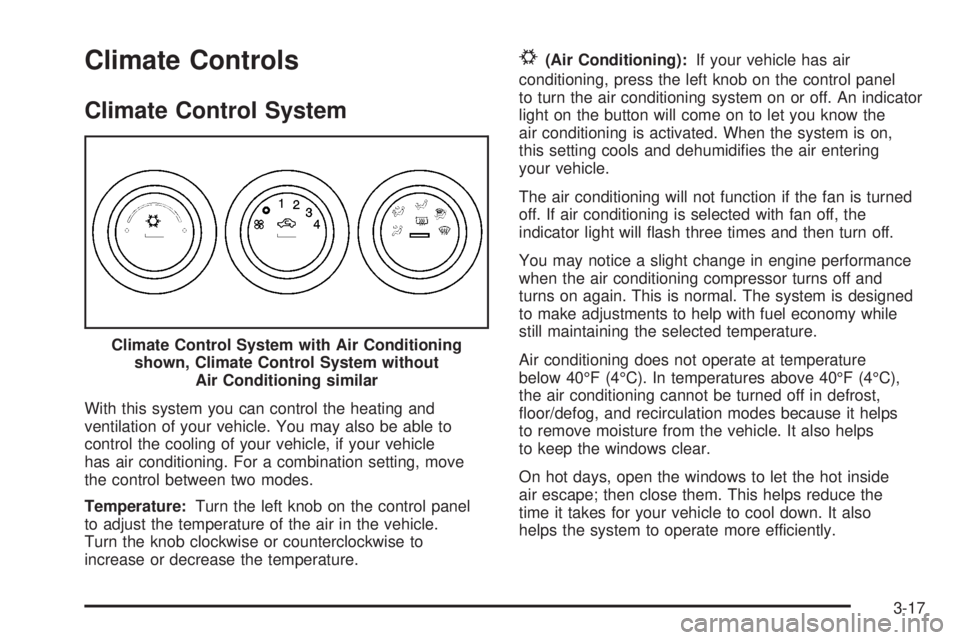
Climate Controls
Climate Control System
With this system you can control the heating and
ventilation of your vehicle. You may also be able to
control the cooling of your vehicle, if your vehicle
has air conditioning. For a combination setting, move
the control between two modes.
Temperature:Turn the left knob on the control panel
to adjust the temperature of the air in the vehicle.
Turn the knob clockwise or counterclockwise to
increase or decrease the temperature.
#(Air Conditioning):If your vehicle has air
conditioning, press the left knob on the control panel
to turn the air conditioning system on or off. An indicator
light on the button will come on to let you know the
air conditioning is activated. When the system is on,
this setting cools and dehumidi�es the air entering
your vehicle.
The air conditioning will not function if the fan is turned
off. If air conditioning is selected with fan off, the
indicator light will �ash three times and then turn off.
You may notice a slight change in engine performance
when the air conditioning compressor turns off and
turns on again. This is normal. The system is designed
to make adjustments to help with fuel economy while
still maintaining the selected temperature.
Air conditioning does not operate at temperature
below 40°F (4°C). In temperatures above 40°F (4°C),
the air conditioning cannot be turned off in defrost,
�oor/defog, and recirculation modes because it helps
to remove moisture from the vehicle. It also helps
to keep the windows clear.
On hot days, open the windows to let the hot inside
air escape; then close them. This helps reduce the
time it takes for your vehicle to cool down. It also
helps the system to operate more efficiently. Climate Control System with Air Conditioning
shown, Climate Control System without
Air Conditioning similar
3-17
Page 115 of 348

Defogging and Defrosting
Fog on the inside of windows is a result of high humidity
(moisture) condensing on the cool window glass. This
can be minimized if the climate control system is used
properly. There are two modes to clear fog or frost from
your windshield and side windows. Use the defog mode
to clear the windows of fog or moisture and warm the
passengers. Use the defrost mode to remove fog or frost
from the windshield more quickly. For best results, clear
all snow and ice from the windshield before defrosting.
Use a temperature setting that provides warm air.
The warmer the air the quicker the windows will clear.
To prevent fogging on the inside of the windows in modes
other than �oor/defog and defrost, make sure the air
conditioning compressor, if the vehicle has one, is on
and recirculation mode is off.
/(Floor/Defog):Turn the right knob on the control
panel to this mode to direct the air to the windshield, the
side window outlets, and to the �oor outlets. When you
select this mode, the system runs the air conditioning
compressor unless the outside temperature is near
freezing or below.
0(Defrost):Turn the right knob on the control panel
to this mode to direct most of the air to the windshield,
and the side window outlets. When you select this mode,
the system runs the air conditioning compressor unless
the outside temperature is near or below freezing.
Do not drive the vehicle until all the windows are clear.
Rear Window Defogger
The rear window defogger uses a warming grid to
remove fog or frost from the rear window. Be sure to
clear as much snow from the rear window as possible.
An indicator light on the knob will come on to show that
the rear window defogger is activated. The rear window
defogger will turn off about �fteen minutes after the knob
is pressed. If turned on again, the defogger will run for
about seven and one-half minutes before turning off.
If the vehicle speed is greater than 50 mph (80 km/h)
and the rear defogger is active, it will remain on as
long as the speed is greater than 50 mph (80 km/h).
The defogger can also be turned off by pressing the
knob again or by turning off the engine.
=(Rear Defogger):Press the right knob on the
control panel to turn the rear window defogger on or off.
Do not operate rear defogger when convertible top
is down.
Notice:Do not use anything sharp on the inside
of the rear window. If you do, you could cut or
damage the warming grid, and the repairs would
not be covered by your warranty. Do not attach a
temporary vehicle license, tape, a decal or anything
similar to the defogger grid.
3-19
Page 116 of 348
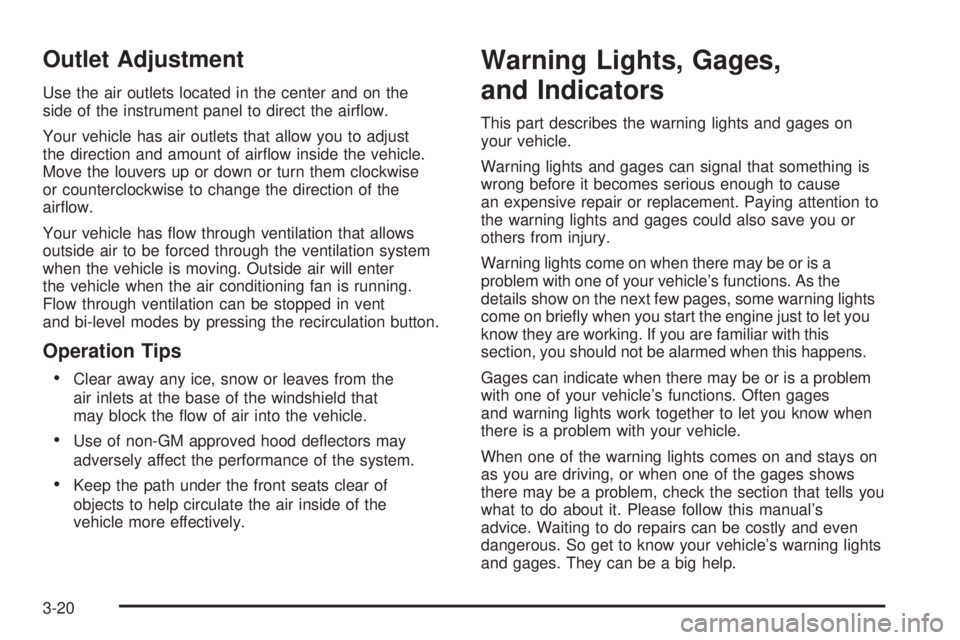
Outlet Adjustment
Use the air outlets located in the center and on the
side of the instrument panel to direct the air�ow.
Your vehicle has air outlets that allow you to adjust
the direction and amount of air�ow inside the vehicle.
Move the louvers up or down or turn them clockwise
or counterclockwise to change the direction of the
air�ow.
Your vehicle has �ow through ventilation that allows
outside air to be forced through the ventilation system
when the vehicle is moving. Outside air will enter
the vehicle when the air conditioning fan is running.
Flow through ventilation can be stopped in vent
and bi-level modes by pressing the recirculation button.
Operation Tips
Clear away any ice, snow or leaves from the
air inlets at the base of the windshield that
may block the �ow of air into the vehicle.
Use of non-GM approved hood de�ectors may
adversely affect the performance of the system.
Keep the path under the front seats clear of
objects to help circulate the air inside of the
vehicle more effectively.
Warning Lights, Gages,
and Indicators
This part describes the warning lights and gages on
your vehicle.
Warning lights and gages can signal that something is
wrong before it becomes serious enough to cause
an expensive repair or replacement. Paying attention to
the warning lights and gages could also save you or
others from injury.
Warning lights come on when there may be or is a
problem with one of your vehicle’s functions. As the
details show on the next few pages, some warning lights
come on brie�y when you start the engine just to let you
know they are working. If you are familiar with this
section, you should not be alarmed when this happens.
Gages can indicate when there may be or is a problem
with one of your vehicle’s functions. Often gages
and warning lights work together to let you know when
there is a problem with your vehicle.
When one of the warning lights comes on and stays on
as you are driving, or when one of the gages shows
there may be a problem, check the section that tells you
what to do about it. Please follow this manual’s
advice. Waiting to do repairs can be costly and even
dangerous. So get to know your vehicle’s warning lights
and gages. They can be a big help.
3-20
Page 118 of 348
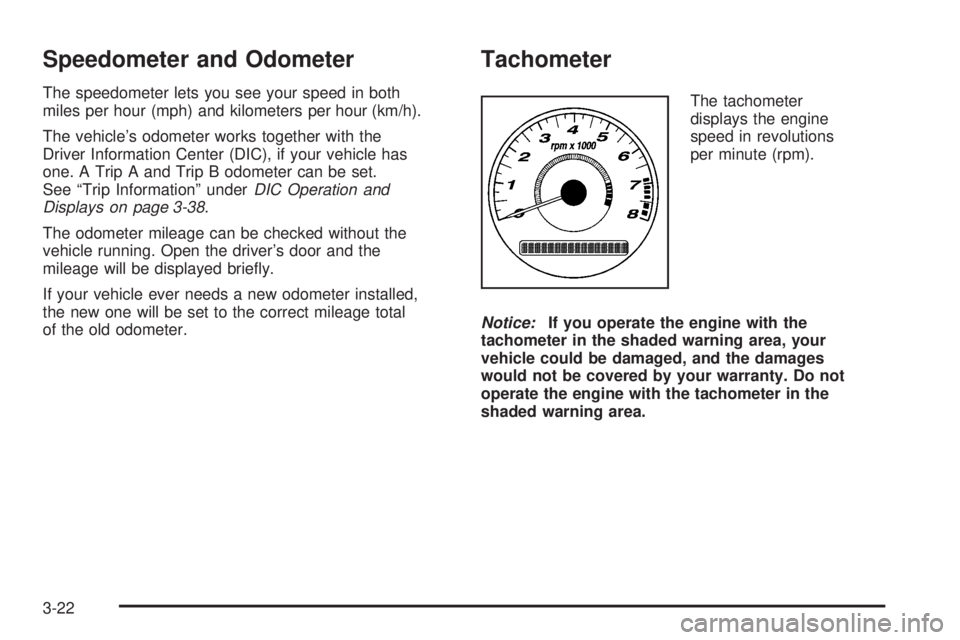
Speedometer and Odometer
The speedometer lets you see your speed in both
miles per hour (mph) and kilometers per hour (km/h).
The vehicle’s odometer works together with the
Driver Information Center (DIC), if your vehicle has
one. A Trip A and Trip B odometer can be set.
See “Trip Information” underDIC Operation and
Displays on page 3-38.
The odometer mileage can be checked without the
vehicle running. Open the driver’s door and the
mileage will be displayed brie�y.
If your vehicle ever needs a new odometer installed,
the new one will be set to the correct mileage total
of the old odometer.
Tachometer
The tachometer
displays the engine
speed in revolutions
per minute (rpm).
Notice:If you operate the engine with the
tachometer in the shaded warning area, your
vehicle could be damaged, and the damages
would not be covered by your warranty. Do not
operate the engine with the tachometer in the
shaded warning area.
3-22